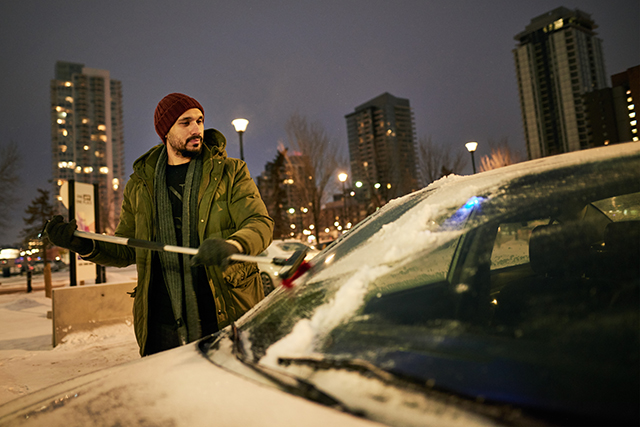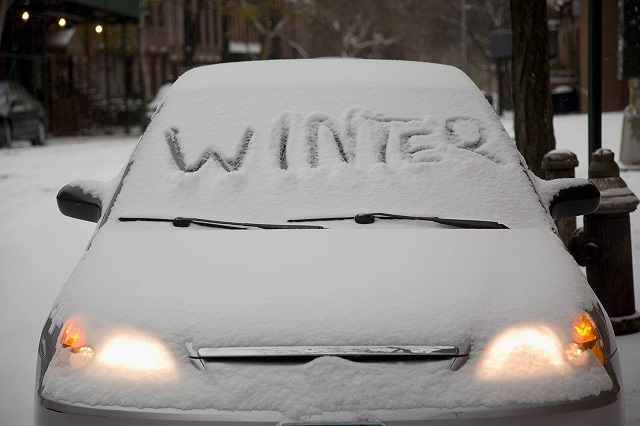Snowfall is a visual delight but a logistical nightmare if you’re trying to drive. Cold weather, snow, ice and sleet – not to mention the chemicals used to melt them – can wreak havoc on your vehicle.
But improperly ridding your vehicle of ice and snow can make things worse and even cause long-lasting damage. Once winter arrives, you’ll need to know the answers to these cold weather car maintenance questions.
How to defrost car windows effectively and efficiently
Start with a properly operating heater. If the engine is not getting up to the proper operating temperature, the defroster will be much less effective. Set the climate control to full defrost rather than bi-level. This will direct the maximum airflow at the windshield.
If your car has the option, the defroster should be on the fresh air setting rather than re-circulated air.
Get tips on how to defog your car windows here.
How can you remove snow without damaging your car?
Use a long-handle snow brush or snow broom (sometimes called a snow rake). Clean from the middle and push or pull the snow. Doing this before the snow turns into ice will prevent damaging the paint.
Clean the entire car – hood, roof, lights and license plates.
How does salt damage your car and how can you prevent it from happening?
Salt (sodium chloride) and other road chemicals (magnesium, calcium chloride and other brines) can cause accelerated rusting.
To prevent this, you should clean any accumulated salt off your vehicle as soon as practical. Flushing with clean, fresh water is ideal. During winter, an occasional undercarriage wash will help wash away any built-up salt, sand or other road de-icing chemicals. If your car is covered with sticky brine, salt or other chemical substances, don’t park the car in the garage. The warmer air will speed up the corrosion process. Wash and dry the car before putting it in a garage. Touch up any paint damage (scratches) before it starts to rust.

What’s the best way to remove ice from the car?
If you are able to open the door and get in, do so and start the car. This will allow the vehicle to warm up and begin to melt the ice.
Do not use sharp products – and never use a shovel. A strong plastic ice scraper will do just fine. Another option, once the car starts to heat up and lightly thaw, is banging on the ice with the snow broom to loosen the ice. You can also use an aerosol deicer spray on the glass but be aware this is mostly alcohol and may remove wax from the paint.
Stock up on snow and ice removal tools.
If the car door is frozen shut, what should you do?
Never pour hot water on the door. Although this may get you into the car, you have just added more water that will likely freeze again.
First, make sure to try all the doors. If it’s an SUV, even try the hatch. You may find one door that you can get in. Don’t yank on the door handles as they can break. Try banging your hand along the edge of the door, which may free up the ice. You can also spray deicer on the door and handle. Or just wait until the sun comes out if that’s an option.
Once you get the door open, wipe down all the rubber gaskets to remove any moisture and then spray the gaskets with silicone. This will displace any moisture and prevent door freezing. You should ideally do this a couple of times per year.
- High methanol content in Prestone Windshield De-Icer ensures strong ice melting power
Prices pulled from the Amazon Product Advertising API on:
Product prices and availability are accurate as of the date/time indicated and are subject to change. Any price and availability information displayed on [relevant Amazon Site(s), as applicable] at the time of purchase will apply to the purchase of this product.
Share your tips on how to defrost car windows in the comments below.
When you make a purchase through a third-party link, AAA Northeast could receive revenue. As an Amazon Associate, we earn from qualifying purchases.
49 Thoughts on “How to Defrost Car Windows and Other Winter Conundrums”
Leave A Comment
Comments are subject to moderation and may or may not be published at the editor’s discretion. Only comments that are relevant to the article and add value to the Your AAA community will be considered. Comments may be edited for clarity and length.


















Just want to disagree with those people that recommend lifting your wipers prior to storm! I did it and when I placed my wipers down, the motor snapped inside and wiper was totally disabled. Went back to dealer for repair and he said never ever raise your wipers as they can freeze in that position and break the mechanism. I had an awful time navigating home in the storm!
For a keyed door lock, an automotive lock deicer works great. They come in little spray bottles with a flat nozzle that fits directly into the lock. You can buy one on Amazon. Even modern cars with key fobs have keyholes for emergency use. This is not likely to be your problem, but if it is, this is a great way to deal with it.
Agree with dont pour very hot or boiling water on ice covered glass… temp contrast might crack the glass. But, warm, room temp or a couple degrees above freezing, will melt black ice, which is hard to chip off. For frozen latches and door locks, an old fashioned shop worklight with incandescent bulb or halogen bulb that generates heat, Not the new LED ones that are safe to touch, clear away any snow, hold the front against the metal of the latch or lock and it will warm it and defrost the ice underneath.
If time permits ahead of a storm, put a spare blanket over front and back windshield glass to form a barrier. Snow Peels off by lifting yhe blanket and pulling tot the side when storm is done.
Silicone spray has been mentioned many time… Is everyone referring to the spray WD40 or what is meant by silicone spray?
Hi Carol, silicone spray is a water-resistant lubricant. Traditional WD40 is not silicone based, but they do sell one that is: https://amzn.to/3u4lGmG. Thank you for reading!
I disagree with the suggestion to set the defroster to fresh air rather than recirculate. Fresh air is most likely quite cold. You are likely to get faster results recirculating the already heated air in the car. This would be especially true for cars with marginal heater systems or electric cars in general.
I have used a blow dryer on low heat to defrost my car doors. Works like a charm! Gotta love Northeast winters!
If you still use keys to open your car door, heat them with a match. Do NOT get your car washed if it doesn’t have time to dry completely BEFORE the temperature drops below 32 Degrees
Three preparations I take when a freeze-up is forecast: 1: Spray the drivers side door gasket and latch with silicone so I can readily get in and start the car and turn on defrosters; raise the windshield wipers if possible, otherwise place wax paper between the blade and windshield to free-up the blades to help in clearing windshields; ; keep a couple of surplus spray bottles filled with car antifreeze to liberally spray on key frozen areas.
Didn’t see this mentioned here. Raise your wiper blades up off the windshield before the storm. This not only makes it easier to clear the snow and ice off of the windshield but also prevents a broken wiper blade assembly or burnt out wiper motor. Some vehicles require you to activate the wipers to bring them up from under the hood. Instructions for this should be in your cars manual (that’s the encyclopedia sized book shoved in your glove box).
You state “If your car has the option, the defroster should be on the fresh air setting rather than re-circulated air”‘ how can this work if the air intakes are frozen over?
Hi Robert, thanks for the question. Here’s a response from our Car Doctor John Paul: In most cases the defroster switches to fresh air when selected. Yes if the car is totally encrusted in ice and snow fresh air will be limited until the snow is clear- but then again you wouldn’t be driving a car covered in ice and snow.
To defrost your windshield quickly, use the full defrost option rather than heat and defrost. Lower both windshield visors all the way down; this will aim warm air directly up the windshield. It really works!
Isn’t there a risk to having the windshield crack? That is, when the glass is too cold, and then you put heat on. I had it happen once, and that’s what the glass repairman told me. He said not to put the defroster on immediately. Let the inside of the car warm up a bit first.
I’m in my 70s and have never had any windshield cracking when putting the defroster on high plus my rear windshield defroster on high. I go to the ice-covered car about 15 minutes before I need to drive, put the defrosters on high and put on recirculating inside air that warms the car quickly. I just did it yesterday here in Maine and it worked like a charm, as always.
Here’s a tip for lessening the chance of your doors icing up after a car wash on a cold winter’s day:
As soon as the car exits the wash bay (and if someone is there to dry off windows and some of the exterior) I pull over, open all the doors, but then only shut them until the lock (partly) engages – not shut tight, but it won’t open when pulled on.
I then drive with the heater blasting max temperature, max blowing for a little bit – to force hot air out of the spaces between the partially-shut doors and the body of the car – to dry those areas.
After a while I get out and push all the doors fully shut.
To prevent freezing after a car wash, open the doors and hatch and wipe the door edges and door frames with a towel. Not only does this prevent freezing, it may remove any dirt that was missed by the car wash workers. It takes minutes to finish the door areas and prevents freezing. Your personal touch !